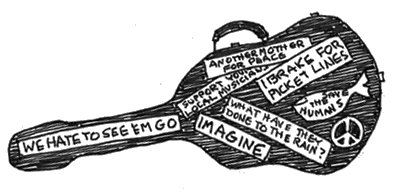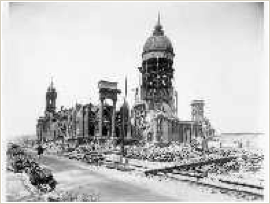


If
you went to school back in the day, you learned “The Midnight Ride of
Paul Revere,” and the eighteenth of April was graven in your memory,
making it easy to remember the anniversary of the San Francisco
earthquake and fire of 1906. I’ve picked up a couple of books on
earthqakes and other “natural” disasters, since my mother was, at the
age of five-and-a-half, displaced by the 1906 San Francisco earthquake
and fire. From Acts of God: The Unnatural History of Natural Disaster in America, (Ted
Steinberg, Oxford U. Press, 2000) I learn that buildings in 1906 were
then insured for loss or damage from fire but not from earthquake, so it
was in the interest of owners to report that the fire, not the
earthquake, had done the damage. This even though 95% of chimneys
toppled (including the one in the building where my mother lived).
Developers
and railroads also had an interest in describing the disaster as a
fire, not an earthquake, as fire could happen anywhere, and would not be
seen as a specific defect of the city they were promoting. Stiffening
of building codes was couched in terms of “wind resistance” rather that
“earthquake resistance,” and relaxed within a few years, over the
objections of seismologists and engineers. The book includes a
reproduction of a postcard of the fire with earthquake damage removed by
an artist. Gladys Hansen, city archivist in the 1960s, noticed
discrepancies in the death figures—Chinatown was flattened, yet there
were only eleven Asian names on the rolls. Death tolls at the time of
the earthquake and fire were reported in the 400s to the 600s. Hansen
estimated more than 2000 deaths.
Since
subsequent earthquakes (Santa Barbara, 1925 and Long Beach, 1933) were
not followed by fires, it was harder to cover up the truth. After the
1933 earthquake (my mother was present for that one, too) statewide
standards were set for earthquake-resistant construction of school
buildings, and later of all new buildings. And it was finallly safe for
MGM to make the 1906 quake into a movie, San Francisco.
I’ve
been in two big earthquakes myself, the Tehachapi earthquake when I was
a kid in Long Beach and the Loma Prieta in 1989 in the house where I
live now. In both cases I was far from the center and the buildings I
was in weren’t damaged. The shaking was long and scary, though. And I
had my house earthquake-retrofitted soon after the Loma Prieta.
But
my own earthquake story is about an aftershock of the Northridge quake
in Southern California. I was on my way to the Beverly Hills Public
Library to do a storytellling program. We were stopped at a stop sign
when the car shook, and I thought we’d been rear-ended. Then I noticed
the stop sign was shaking. Storyteller Angela Lloyd met us at the
library to say it was being evacuated, minor damage, so no program. She
had come down from Victorville to see it, and there were a couple of
families there too, so I suggested we have the program in a little park
across the street. We were all on a little survival high and the program
was fun, despite interruptions from passing fire engines. Then the
librarians and storytellers went out for coffee.
April
18 is also the second anniversary of Claudia’s sister’s death. Claudia
is running a couple of in memoriam ads in the Village Voice, Susan’s
neighborhood paper. One includes the lyrics I wrote about her:
SUSAN’S SONG
You brought together colors
Of every different hue,
I wouldn’t think to mix them,
But they always matched for you.
You brought together people
Of every different kind
Rich and poor, black and white
Were neighbors in your mind
You saw the world in your own way
Followed your own road
For you it wasn’t easy
To let somebody share your load
A year ago you left us
For the other shore
But the dogs that you befriended
Still linger at your door
Baskets full of rainbows
Your pockets full of treats
You could make a village
Come alive in city streets
©2009 by Nancy Schimmel

Friday, April 17, 2009


’TWAS THE EIGHTEENTH OF APRIL






